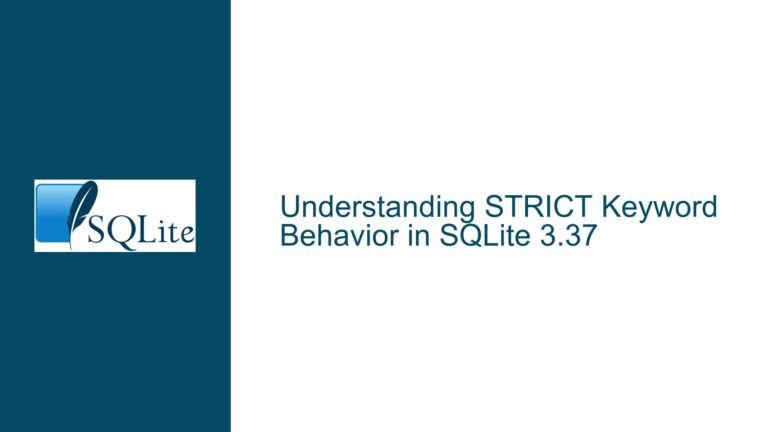SQLite Missing CREATE OR REPLACE TABLE Syntax Support
Absence of Atomic Table Replacement in Schema Management Workflows
The absence of CREATE OR REPLACE TABLE syntax in SQLite introduces friction in iterative development workflows where tables must be redefined frequently. This syntax is equivalent to executing DROP TABLE IF EXISTS followed by CREATE TABLE in a single atomic operation. Developers working in environments such as CLI tools, Jupyter notebooks, or data loader scripts face repetitive manual steps when refining table schemas or reloading data. For example, a developer iterating on a table definition in the sqlite3 command-line interface must manually execute DROP TABLE before re-running a CREATE TABLE statement. This disrupts workflow efficiency, especially when testing schema changes or reprocessing data pipelines. The lack of native support forces developers to write additional code to handle table existence checks, deletion, and recreation, which increases cognitive overhead and script complexity.
The problem extends to scenarios where foreign key constraints or schema dependencies exist. Dropping a table without considering dependent objects (e.g., views, triggers, or foreign keys) risks breaking database integrity. While some databases implement CREATE OR REPLACE TABLE with safeguards or cascading behaviors, SQLite’s current design requires explicit handling of these dependencies. Developers working with virtual tables or materialized views face similar challenges, as SQLite does not natively support CREATE OR REPLACE semantics for these objects either. The absence of this feature complicates cross-database compatibility for applications migrating from systems like DuckDB or BigQuery, where CREATE OR REPLACE is standard.
Technical Constraints and Design Philosophy
SQLite’s lack of CREATE OR REPLACE TABLE support stems from its minimalist design philosophy and technical constraints. SQLite prioritizes stability, backward compatibility, and a small footprint, which historically discouraged adding syntactic sugar that could bloat the parser or introduce edge cases. The REPLACE keyword is already used in contexts like CREATE VIEW and CREATE TRIGGER, but extending it to CREATE TABLE requires resolving ambiguities in transaction handling and schema versioning. For instance, replacing a table atomically while preserving transactional integrity (ACID properties) is non-trivial. SQLite’s file-based architecture ensures that schema changes are transactional, but replacing a table involves multiple system catalog updates (e.g., sqlite_master entries, index rebuilding), which must be atomic to prevent corruption.
Another constraint is the interaction with foreign key constraints. When a table is dropped, SQLite’s DROP TABLE behavior automatically removes associated indexes and triggers but does not cascade to foreign keys in other tables. This means a CREATE OR REPLACE TABLE operation could orphan foreign key references if not handled explicitly. Implementing automatic cascade semantics would conflict with SQLite’s "fail early" approach to schema integrity, where developers are expected to manage dependencies explicitly. Additionally, virtual tables (e.g., FTS5) or attached databases introduce further complexity, as their creation logic often involves external modules or runtime parameters that are not easily captured in a REPLACE operation.
The lack of demand from SQLite’s primary use cases (embedded systems, lightweight applications) also contributes to the feature’s absence. However, as SQLite gains traction in data engineering and notebook-based workflows, the need for developer-friendly syntax has grown. Competing databases like DuckDB prioritize usability for analytical workloads, which explains their early adoption of CREATE OR REPLACE TABLE. SQLite’s parser and syntax rules are intentionally conservative, making new keyword introductions a high-barrier change. For example, the OR REPLACE clause would need to be parsed unambiguously alongside existing constructs like CREATE TEMPORARY TABLE or CREATE TABLE IF NOT EXISTS, requiring careful lexer and parser adjustments.
Mitigating Workarounds and Long-Term Solutions
Developers can mitigate the absence of CREATE OR REPLACE TABLE using transactional scripting, external automation, or schema isolation techniques. A common workaround is wrapping DROP TABLE IF EXISTS and CREATE TABLE in a transaction to approximate atomicity:
BEGIN TRANSACTION;
DROP TABLE IF EXISTS users;
CREATE TABLE users(id TEXT PRIMARY KEY, name TEXT, age INT);
COMMIT;
This ensures that either both statements succeed or neither is applied, preventing partial schema states. However, this approach does not address foreign key constraints or dependent objects. Developers must manually drop and recreate dependent views or triggers, or disable foreign key checks temporarily:
PRAGMA foreign_keys = OFF;
BEGIN TRANSACTION;
DROP TABLE IF EXISTS users;
CREATE TABLE users(id TEXT PRIMARY KEY, name TEXT, age INT);
COMMIT;
PRAGMA foreign_keys = ON;
Disabling foreign keys is risky and should be used cautiously, as it can lead to integrity violations if data is reloaded inconsistently.
For CLI workflows, developers can automate table replacement using shell scripts or command chaining. In the sqlite3 command-line interface, the .once and .read directives allow executing multi-statement scripts:
sqlite3 test.db ".once /tmp/create_users.sql" "DROP TABLE IF EXISTS users; CREATE TABLE users(id TEXT, name TEXT);"
Jupyter notebook users can encapsulate table recreation logic in a single cell using semicolon-separated statements. For large datasets, combining DROP TABLE with INSERT INTO ... SELECT can preserve data while redefining the schema, though this requires careful column mapping.
Long-term solutions involve advocating for CREATE OR REPLACE TABLE support in SQLite’s core. Developers can submit patches to the SQLite project that implement the syntax, ensuring compatibility with existing REPLACE clauses. The implementation would need to mirror DROP TABLE’s behavior, including removing indexes and triggers, while avoiding conflicts with transactional DDL. Community-driven forks or extensions could prototype the feature, though widespread adoption would depend on upstream acceptance. Until then, leveraging SQLite’s programmability via extensions (e.g., user-defined functions) or preprocessor scripts that rewrite CREATE OR REPLACE into DROP/CREATE pairs offers a stopgap.
For virtual tables or views, the same transactional patterns apply. Replacing a virtual table requires re-registering its module and parameters, which can be scripted but lacks atomicity. Developers should consider isolating volatile schema objects in separate databases or using ATTACH DATABASE to minimize disruption. In all cases, thorough testing with .schema commands and integrity checks (PRAGMA integrity_check) is recommended after schema changes to ensure consistency.






